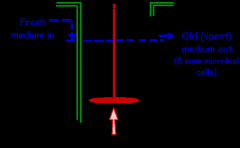![]()
![]()
![]()
Use LEFT and RIGHT arrow keys to navigate between flashcards;
Use UP and DOWN arrow keys to flip the card;
H to show hint;
A reads text to speech;
22 Cards in this Set
- Front
- Back
|
Name at least 4 micronutrients?
|
calcium, iron, magnesium, manganese, zinc, etc.
|
|
|
name at least 4 macronutrients?
|
carbon, nitrogen , sulphur
|
|
|
Taxonomy Hierachical??
|
Domain e.g. bacteria
Phylum e.g. Proteobacteria Class e.g. αβγδε Proteobacteria Family e.g. Enterobacteriaceae Genus e.g Escherichia Species e.g. coli |
|
|
difference between phototrophs and auxotrophs
|
phototrophs will grow on a defined medium
auxotrophs willrequire additional growth factors |
|
|
heamocytometer
advantages: |
Advantages
inexpensive equipment can distinguish between cells and inanimate matter can differentially count two (or more) morphologically distinct species |
|
|
heamocytometer:
disadvantages |
lengthy process
subject to human error |
|
|
heamocytometer:
total count? average cell count per small square = 7 volume of large square = 0.1mm3 (= 10-4 cm3) dilution = none |
Total count in cm3 =
cell count in large square x 1/volume of large square in cm3 x 1/dilution factor Total count = 7 x 16 x 25 x 1/10-4 = 7 x 400 x 104 = 2.8 x 107 cells per cm3 |
|
|
coulter counter advantages:
|
automated and rapid respeonse
no human error |
|
|
coulter counter disadvantages
|
requires expensive equiptment
cannot tell teh difference between cells and inament matter cant count two or more different species |
|
|
coulter counter
total count average cell count = 12345678 volume sampled = 0.5 cm3 dilution = 1/10 (or 10-1 |
Total count in cm3 =
average cell count x 1/volume sampled in cm3 x 1/dilution factor Total count =12345678 x 1/0.5 x 1/10-1 = 12345678 x 2 x 101 = 246913560 = 2.5 x 108 cells per cm3 |
|
|
Draw a continuous culture diagram
and what are it's key features? |

A continuous culture system consists of a growth chamber supplied with fresh medium.
The medium must contain a growth limiting substrate. The growth limiting substrate may be a carbon or nitrogen |
|
|
What is the CI index:
|
maximum tolerated dose/minimum curative dose.
It is a measure of selective toxicity |
|
|
What is Selective toxicity ?
|
achieved by targeting components in microorganisms that are absent in human cells.
|
|
|
what is minimum inhibitory concentration (MIC)
|
MIC is the lowest concentration that inhibits growth.
|
|
|
Whats the difference between antiseptics and disinfectants?
|
disinfectants are used to reduce a viable microbial population below a threshold that causes infection
They are used on inanimate objects. Antiseptics serve the same purpose but are used on living tissue |
|
|
Factors that influence the efficacy of chemical disinfectants?
|
Sterility of antiseptics
Effective concentration Time of exposure PH Temperature of exposure pH |
|
|
Control of protein synthesis :
Level of control None and example |
Constitutive
Gylcolitic enzmyes |
|
|
Transcription:
|
Induction : lactose operon
repression: typhan operon |
|
|
translation:
|
Autogenes: ribosomal protiens
|
|
|
Examples of enriched medium? 2
|
Chocolate agar (heated horse blood)Streptococcus
odd ager bl horse blood |
|
|
heterotrophs, autotrophs, photoautotrophs and chemoautorophs
|
Photo=light
auto=self troph=feeding chemo=chemical hetero=both |
|
|
Modes of action of disinfectants? What do Alcohols, Glutaraldhydes and formaldehydes, Halogens do?
|
Alcohols, 70-75%, denature proteins
Glutaraldehydes (2%) and formaldehydes (5-8%) cross-link proteins and nucleic acids Halogens include hypochlorous acid (0.1-0.2%) which yield chlorinated nucleotide bases, iodine (1-2%) interacts with nucleotides, fatty acids & amino acids |

